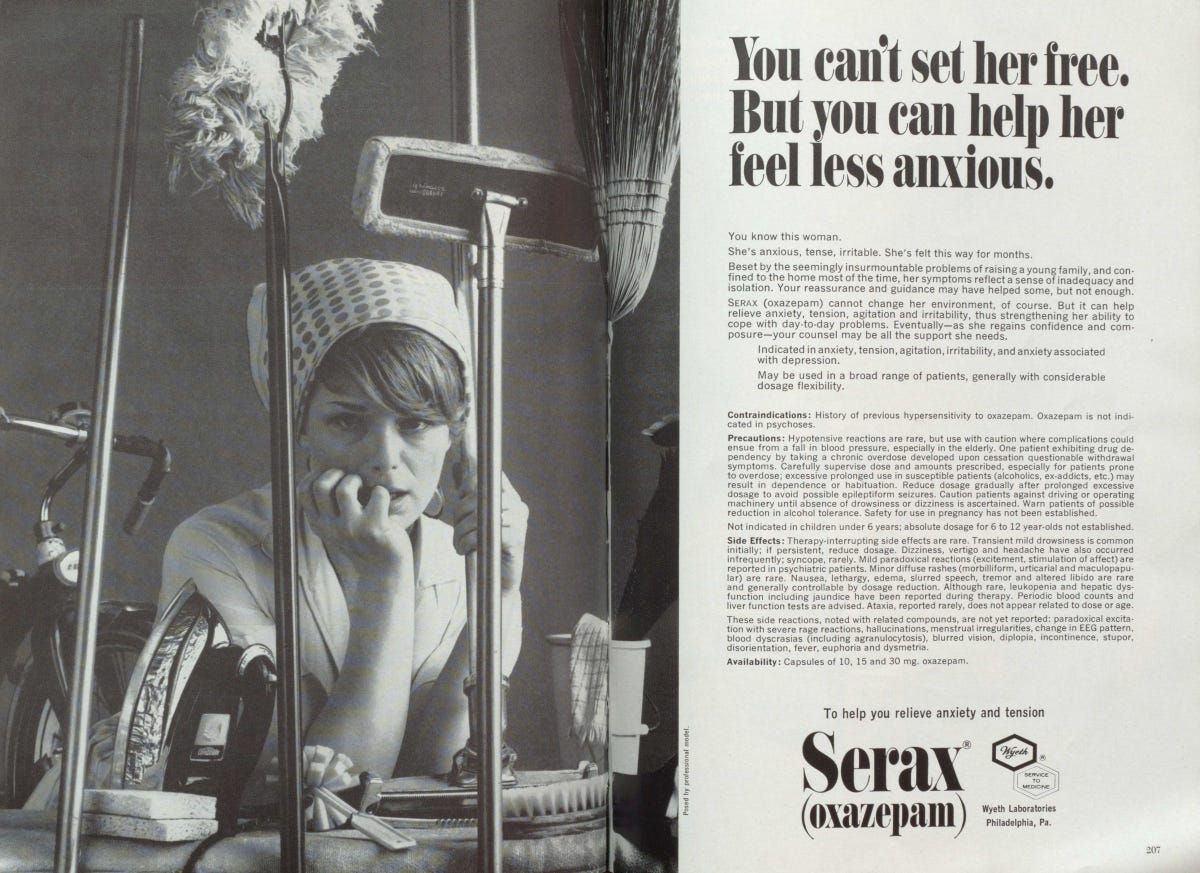Link List 005
In search for the center of the Internet
Very Bad Wizards discuss half-beliefs, social scripts, and superstitions in Episode 266. I appreciate superstitions more and will now avoid saying the ‘Q’ word while on call and in front of peers.
1960's benzodiazepine ad.
More and more of life is spent in the digital realm (which really just serves as an extension of the inner life)
But at what cost? I find the visual representation of this digital curse - an infinite flow of distraction - powerful. More from the artist found here
Supernuclear is a substack dedicated to the practicalities (group decision-making, rituals, making rules) and details (rent v buy, legal paperwork, etc.) of co-purchasing properties for creating co-living communities beyond your nuclear family. Here is their wonderfully detailed directory
Oliver Burkeman (who wrote Four Thousand Hours, which I write about here) and Johnathan Shelder (a psychoanalyst who demystified and made analytic concepts much more understandable to me) have a discussion about psychoanalysis. Another case of serendipitously coming across two people I follow independently talking to each other.
100 (big) little ideas from Morgan Housel
AI-Generated Art (like 5 months after it was popular). Maybe it's new to you, maybe it's a reminder.



AI generated art Anytime people don’t see the relevance of cryptocurrency, I can’t help but feel like they are the analog of these people in 1993 balking at the introduction of a credit card at Burger King
Exa is a unique search engine for the internet. It feels like searching reddit for answers in the sense that its results are more ‘organic’. When I type in ‘blog about mental health and philosophy from a psychiatrist’, many of the top results are from our friend Awais Aftab over at Pyschiatry at the Margins! When I do the same on google, I get mostly businesses, the APA (American Psychiatric Association) website, etc. It feels like searching the internet before it became ‘popular’ and you would come across the various blogs and niche communities/sub-cultures. It’s not a google replacement, but an interesting way to search for things you are interested in.
Speaking of the devil, DSM Disorders Disappear in Statistical Clustering of Psychiatric Symptoms, by Awais Aftab
I spend way too much time thinking about the nature of consciousness, the self, and more. Any worthwhile theory of these phenomena needs to take into account all the edge cases. Lucid dreams, psychosis, Anterograde memory dysfunction (Like Korsakoff syndrome), and such are examples. But there are further cases really on the edge - Like the Craniophagus Twins in Canada at the moment - Krista and Tatiana Hogan. On their Wikipedia page, it notes that they have described “how they can feel and taste what the other is experiencing. Later it was also confirmed that they can see through each other's eyes.” Experience what another person is experiencing?? And there is the Dicephalic Parapagus twins Abby and Brittany Hensel. In this case, two minds control only one pair of arms and legs.


Left, Krista and Tatiana. Right, Abby and Brittany From Twitter (Now X): You are given an urn containing 100 balls; n of them are red, and 100-n are green, where n is chosen uniformly at random in [0, 100]. You take a random ball out of the urn—it’s red—and discard it. Is the next ball you pick (out of the 99 remaining) more likely to be red than it is green, or more likely to be green than red, or are the two equally likely? <Answer at the bottom in the footnote>1
Apparently, female named hurricanes are deadlier than male hurricanes. The theory is that their names sound less menacing, fewer people evacuate, and more deaths occur.
The unique architecture and components of a ‘space’ (home, business building, etc.) are often not the most expensive part, but they add tremendous value in ‘uniqueness’ points. Case in point.
Ketamine: WD-40 for the Bayesian brain. I try not to get my information about drugs from blog posts, but sometimes, it leads to interesting findings.
Superb Owl’s Intersubjective Continuum.
Xenobots - tiny biodegradable and environmentally friendly robots. Unlike traditional technologies, xenobots do not generate pollution or require external energy inputs during their life-cycle. They are synthetically derived from transplanting together 2 things: skin cells and cardiac cells. That’s it. It’s like a tiny biological blob without the ‘life’ in it. The skin cells provide rigid support, and the heart cells act as small motors, contracting and expanding in volume to propel the xenobot forward. Their use cases are still being worked on, but “it has been speculated that future xenobots might be able to find and aggregate tiny bits of ocean-polluting microplastics into a large ball of plastic that a traditional boat or drone could gather and bring to a recycling center. In future clinical applications, such as targeted drug delivery, xenobots could be made from a human patient’s own cells, which would virtually eliminate the immune response challenges inherent in other kinds of micro-robotic delivery systems. Such xenobots could potentially be used to scrape plaque from arteries, and with additional cell types and bioengineering, locate and treat disease. “
I don’t believe it will come to fruition, but The Line in Saudi Arabia is still a thing.
Anand’s Immortal Chess Match (Grandmaster Viswanathan Anand versus Grandmaster Levon Aronian)
In the 1960’s, three superstar therapists of three different theories/methodologies all interviewed the same patient - Gloria. Fritz Perls uses a quasi-abrasive gestalt approach (at times, he calls the patient a phony while smoking a cigarette). Carl Rogers uses a ‘Humanistic Person-Centered’ approach with slabs of empathy. Lastly, Dr. Ellis who uses a rational emotive therapy that’s kind of an educational between(?). Stealing a top-level comment from one of the videos:
“What's interesting about all three therapists is that in their own way they helped Gloria, and in a connective theme:
Fritz used a confrontational style grounded in the here-and-now to help Gloria discover a aspects of her personality that she kept hidden, which largely dealt with insecurity, i.e., shyness, fear of judgment, fear of not being equal enough.
Rogers used an unconditionally loving nonjudgmental/non-confrontational/non-directive style, by which he helped foster Gloria's self esteem to overcome her shyness and fears of insecurity so that she could realize the answers, let alone the questions, to her own problems.
Ellis use a more directive, informative/educational model, highlighting for Gloria how her fears and insecurities are based in faulty perceptions/beliefs that led to maladaptive perceptions/behaviors affecting her life and thereby overall emotional condition. He moves quickly and continuously helps her to correct the automatic framing her unconscious minds attempts at each faulty though process.
In conclusion, all three therapists saw the core of her crisis, at least in identifying a shared theme within this brief session, and in their own way, worked with that theme.
The key to this question is that pulling out a red ball tells you something about the container’s contents. Although we don’t know the actual composition, we know that we are likely pulling from a container with lots of red balls because if it were mostly green balls (n =75), we would likely have pulled a green ball. And if we know we are probably pulling from a bag container of more red than green balls, we know that pulling another ball, will still likely be red. In short, the first ball you take out doesn’t change the composition that much, but it gives a lot of information about the original composition.







